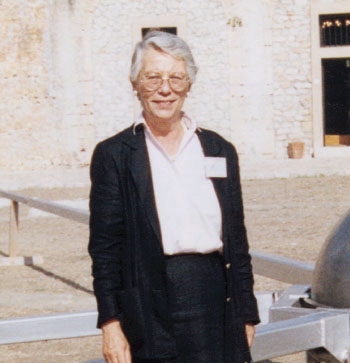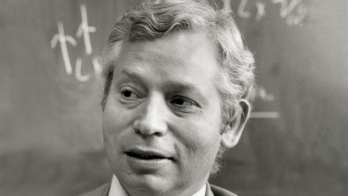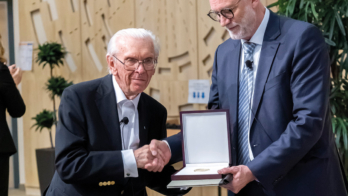
Bianca Monteleoni-Conforto 1937-1999
With great sadness we learned on 18 May that Bianca Monteleoni-Conforto had left us.
Bianca first came to CERN in 1962 after working in Rome on antiproton interactions in emulsions. The 81 cm bubble chamber had been exposed to the first CERN antiproton beams and Bianca plunged into the analysis of a low-energy scattering experiment, displaying from the outset her personal qualities a preference for solid work, producing numbers and facts. Her perseverance overcame all obstacles, and she took pride in the eventual result. Her enthusiasm led others to collaborate, at which point she would step back, except when it was vital to intervene.
The wide-ranging antiproton study, extending to kaon production, laid the ground for subsequent LEAR studies. Kaon interactions retained Bianca’s interest in Chicago, where she spent two years, and later at the UK Rutherford Laboratory. Back in Rome, she turned to CERN’s SPS and neutrino physics, for the beam dump experiment, which brought the first observation of charm production in hadronic interactions. She continued heavy flavour studies in a photoproduction experiment with the Omega spectrometer, later joining the Crystal Ball experiment at DESY.
In 1980 Bianca moved to a research position in Florence, where she displayed her qualities for organizing and for driving a team of young researchers, and embarked on the construction of the Muon Filter for the L3 experiment at CERN’s LEP.
Increasingly involved in INFN activities (she became a director in Florence in 1987) and teaching (19 theses supervised), Bianca continually followed new developments. She and her group joined the LVD experiment at Gran Sasso, and pushed the NESTOR underwater neutrino experiment in Pylos, Greece. Her work thus covered a variety of experimental particle physics and even astrophysics.
Bianca was respected and loved by all of us. Besides her standing as a scientist, she had great human qualities, open to the beauty of physics as well as music and arts. It was not only good to work with her, but also to walk in Rome or hear an opera with her, to feel, in life as in physics, her solidity and fidelity, and to share her humour. We will miss her greatly.
Friends of Bianca.

Rostislav Mikhailovich Ryndin 1929-99
Leading Russian theoretical physicist Rostislav Mikhailovich Ryndin passed away on 23 March after a protracted illness.
Born in Leningrad in 1929 into the family of a university lecturer, R M (Slava to his numerous friends), like all of his contemporaries, he spent his early life in difficult times. He remained in Leningrad throughout the worst of the siege until September 1942, his father dying of starvation in his arms. Later he endured evacuee hardships and could hardly stand following severe typhoid.
Returning to Leningrad, he graduated in 1952 and started work in Novo-Ivan’kovo (now Dubna), in the Hydrotechnical Laboratory, at that time top secret before becoming the Institute for Nuclear Problems, and then later the Joint Institute for Nuclear Research.
Ryndin had a deep understanding and wide knowledge of physics, particularly the physics of spin. His initial interests at Dubna were in nucleon and pion scattering. For a complete reconstruction of scattering amplitudes, he and his coauthors made a deep study of polarization effects. This classic work, which formed the basis for his PhD (1958), is still applied and referred to. Then he investigated the detailed relations between polarization effects and interaction symmetries, becoming a doctor of science in 1966.
He was able to visit CERN for the first time as early as 1956. During a year at CERN in 19591960, he collaborated with a US visitor of Russian origin, Boris Jacobsohn, on parity tests for particles. At CERN he gained a fine reputation, retaining numerous contacts till the end of his life.
In 1970, by now world renowned, he moved to the Theory Group of the Leningrad Physico-Technical Institute, subsequently the Theory Division of the Leningrad (now Petersburg) Nuclear Physics Institute. There his best-known publications were on atomic parity violation, followed by investigations of possible macroscopic parity-violating effects in media or wave guides. His final work focused on the motion of spinning particles in electromagnetic fields producing so-called topological effects.
Ryndin was very attentive to young physicists and gave frequent lectures at schools. From a family of intellectuals, he was an intellectual in the best sense of the word, with wide interests, and he had the rare gift of becoming an acknowledged authority and opinion leader in his various spheres of interest. He did not hesitate from being critical.
He was influential in shaping the image of the Theory Division of PNPI. His death is a hard loss for his family, his friends and his collaborators, and the whole physics community, particularly in Russia and at CERN.





